
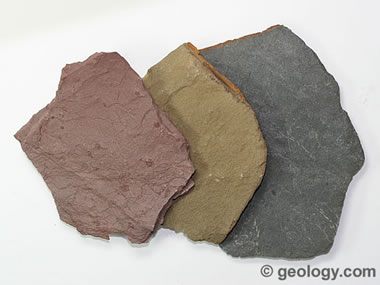
....................................................................................................................................................
Shale is the most abundant
sedimentary rock and is in sedimentary basins worldwide
Article by: Hobart
M. King, Ph.D., RPG
What is Shale?
Shale is a
fine-grained sedimentary rock that forms from the
compaction of silt and clay-size mineral particles that we commonly call
"mud."
This composition
places shale in a category of sedimentary rocks known as "mudstones."
Shale is
distinguished from other mudstones because it is fissile and laminated.
"Laminated"
means that the rock is made up of many thin layers.
"Fissile"
means that the rock readily splits into thin pieces along the laminations.
,
Uses of Shale
,
Uses of Shale
Some shales have
special properties that make them important resources.
Black shales contain
organic material that sometimes breaks down to form natural gas or oil.
Other shales can be
crushed and mixed with water to produce clays that can be made into a variety
of useful objects.
Conventional Oil and Natural Gas
Black organic shales
are the source rock for many of the world's most important oil and
natural gas deposits.
These shales obtain
their black color from tiny particles of organic matter that were deposited
with the mud from which the shale formed.
As the mud was buried
and warmed within the earth, some of the organic material was transformed into
oil and natural gas.
The oil and natural
gas migrated out of the shale and upwards through the sediment mass because of
their low density.
The oil and gas were
often trapped within the pore spaces of an overlying rock unit such as a sandstone (see
illustration).
These types of oil
and gas deposits are known as "conventional reservoirs" because the
fluids can easily flow through the pores of the rock and into the extraction
well.
Although drilling can
extract large amounts of oil and natural gas from the reservoir rock, much of
it remains trapped within the shale.
This oil and gas is
very difficult to remove because it is trapped within tiny pore spaces or
adsorbed onto clay mineral particles that make up the shale.
Unconventional Oil and Natural Gas
In the late 1990s,
natural gas drilling companies developed new methods for liberating oil and
natural gas that is trapped within the tiny pore spaces of shale.
This discovery was
significant because it unlocked some of the largest natural gas deposits in the
world.
The Barnett Shale of
Texas was the first major natural gas field developed in a shale reservoir
rock.
Producing gas from
the Barnett Shale was a challenge. The pore spaces in shale are so tiny that
the gas has difficulty moving through the shale and into the well.
Drillers discovered
that they could increase the permeability of the shale by pumping water down
the well under pressure that was high enough to fracture the shale.
These fractures
liberated some of the gas from the pore spaces and allowed that gas to flow to
the well. This technique is known as "hydraulic fracturing" or
"hydrofracing."
Drillers also learned
how to drill down to the level of the shale and turn the well 90 degrees to
drill horizontally through the shale rock unit.
This produced a well
with a very long "pay zone" through the reservoir rock (see
illustration). This method is known as "horizontal drilling."
Horizontal drilling
and hydraulic fracturing revolutionized drilling technology and paved the way
for developing several giant natural gas fields.
These include
the Marcellus Shale in the Appalachians,
the Haynesville Shale in Louisiana and
the Fayetteville Shale in Arkansas.
These enormous shale
reservoirs hold enough natural gas to serve all of the United States' needs for
twenty years or more.
Shale Used to Produce Clay
Everyone has contact
with products made from shale.
If you live in a
brick house, drive on a brick road, live in a house with a tile roof, or keep
plants in "terra cotta" pots, you have daily contact with items that
were probably made from shale.
Many years ago these
same items were made from natural clay. However, heavy use depleted most of the
small clay deposits.
Needing a new source
of raw materials, manufacturers soon discovered that mixing finely ground shale
with water would produce a clay that often had similar or superior properties.
Today, most items
that were once produced from natural clay have been replaced by almost
identical items made from clay manufactured by mixing finely ground shale with
water.
Shale Used to Produce Cement
Cement is another
common material that is often made with shale.
To make cement,
crushed limestone and shale are heated to a
temperature that is high enough to evaporate off all water and break down the
limestone into calcium oxide and carbon dioxide.
The carbon dioxide is
lost as an emission, but the calcium oxide combined with the heated shale makes
a powder that will harden if mixed with water and allowed to dry.
Cement is used to
make concrete and many other products for the construction industry.
Oil Shale
Oil
shale is a rock that contains significant amounts of
organic material in the form of kerogen. Up to 1/3 of the rock can be solid
kerogen.
Liquid and gaseous
hydrocarbons can be extracted from oil shale, but the rock must be heated
and/or treated with solvents. This is usually much less efficient than drilling
rocks that will yield oil or gas directly into a well.
Extracting the
hydrocarbons from oil shale produces emissions and waste products that cause
significant environmental concerns. This is one reason why the world's
extensive oil shale deposits have not been aggressively utilized.
Oil shale usually
meets the definition of "shale" in that it is "a laminated rock
consisting of at least 67% clay minerals."
However, it sometimes
contains enough organic material and carbonate minerals that clay minerals
account for less than 67% of the rock.
Composition of Shale
Shale is a rock
composed mainly of clay-size mineral grains. These tiny grains are usually clay
minerals such as illite, kaolinite, and smectite.
Shale usually
contains other clay-size mineral particles such as quartz, chert,
and feldspar.
Other constituents
might include organic particles, carbonate minerals, iron oxide minerals,
sulfide minerals, and heavy mineral grains.
These "other
constituents" in the rock are often determined by the shale's environment
of deposition, and they often determine the color of the rock.
Colors of Shale
Like most rocks, the
color of shale is often determined by the presence of specific materials in
minor amounts. Just a few percent of organic materials or iron can
significantly alter the color of a rock.
Black and Gray Shale
A black color in
sedimentary rocks almost always indicates the presence of organic materials.
Just one or two percent organic materials can impart a dark gray or black color
to the rock.
In addition, this
black color almost always implies that the shale formed from sediment deposited
in an oxygen-deficient environment.
Any oxygen that
entered the environment quickly reacted with the decaying organic debris. If a
large amount of oxygen was present, the organic debris would all have decayed.
An oxygen-poor environment
also provides the proper conditions for the formation of sulfide minerals such
as pyrite, another important mineral found in
most black shales.
The presence of
organic debris in black shales makes them the candidates for oil and gas
generation. If the organic material is preserved and properly heated after
burial, oil and natural gas might be produced.
The Barnett
Shale, Marcellus Shale, Haynesville Shale, Fayetteville Shale, and other
gas-producing rocks are all dark gray or black shales that yield natural gas.
The Bakken Shale of North Dakota and
the Eagle Ford Shale of Texas are
examples of shales that yield oil.
Gray shales sometimes
contain a small amount of organic matter.
However, gray shales
can also be rocks that contain calcareous materials or simply clay minerals
that result in a gray color.
Red, Brown, and Yellow Shale
Shales that are
deposited in oxygen-rich environments often contain tiny particles of iron
oxide or iron hydroxide minerals such as hematite,
goethite, or limonite.
Just a few percent of
these minerals distributed through the rock can produce the red, brown, or
yellow colors exhibited by many types of shale.
The presence of
hematite can produce a red shale. The presence of limonite or goethite can
produce a yellow or brown shale.
Green Shale
Green shales are
occasionally found. This should not be surprising because some of the clay
minerals and micas that make up much of the volume of these rocks are typically
a greenish color.
Hydraulic Properties of Shale
Hydraulic properties
are characteristics of a rock such as permeability and porosity that reflect
its ability to hold and transmit fluids such as water, oil, or natural gas.
Shale has a very
small particle size, so the interstitial spaces are very small.
In fact they are so
small that oil, natural gas, and water have difficulty moving through the rock.
Shale can therefore
serve as a cap rock for oil and natural gas traps, and it also is an aquiclude
that blocks or limits the flow of groundwater.
Although the
interstitial spaces in a shale are very small, they can take up a significant
volume of the rock. This allows the shale to hold significant amounts of water,
gas, or oil but not be able to effectively transmit them because of the low
permeability.
The oil and gas
industry overcomes these limitations of shale by using horizontal drilling and
hydraulic fracturing to create artificial porosity and permeability within the
rock.
Some of the clay
minerals that occur in shale have the ability to absorb or adsorb large amounts
of water, natural gas, ions, or other substances. This property of shale can
enable it to selectively and tenaciously hold or freely release fluids or ions.
Engineering Properties of Shale Soils
Shales and the soils
derived from them are some of the most troublesome materials to build upon.
They are subject to changes in volume and competence that generally make them
unreliable construction substrates.
Expansive Soils
The clay minerals in
some shale-derived soils have the ability to absorb and release large amounts
of water. This change in moisture content is usually accompanied by a change in
volume which can be as much as several percent.
These materials are
called "expansive soils." When these soils
become wet they swell, and when they dry out they shrink.
Buildings, roads,
utility lines, or other structures placed upon or within these materials can be
weakened or damaged by the forces and motion of volume change.
Expansive soils are
one of the most common causes of foundation damage to buildings in the United
States.
Slope Stability
Shale is the rock
most often associated with landslides. Weathering transforms the
shale into a clay-rich soil which normally has a very low shear strength -
especially when wet.
When these
low-strength materials are wet and on a steep hillside, they can slowly or
rapidly move down slope. Overloading or excavation by humans will often trigger
failure.
Environments of Shale Deposition
An accumulation of
mud begins with the chemical weathering of rocks. This weathering breaks the
rocks down into clay minerals and other small particles which often become part
of the local soil.
A rainstorm might
wash tiny particles of soil from the land and into streams, giving the streams
a "muddy" appearance.
When the stream slows
down or enters a standing body of water such as a lake, swamp, or ocean, the
mud particles settle to the bottom.
If undisturbed and
buried, this accumulation of mud might be transformed into a sedimentary rock
known as "mudstone." This is how most shales are formed.
The shale-forming
process is not confined to Earth. The Mars rovers have found lots of outcrops
on Mars with sedimentary rock units that look just like the shales found on
Earth (see photo).
Hobart
M. King
is the owner and publisher of Geology.com. He is a geologist with over 40 years
of experience, has a Ph.D. in geology, and is a GIA graduate gemologist. Much
of his work has focused on coal geology, industrial minerals, gemology,
geologic hazards, and geoscience education.
He has
authored many of the internet’s most popular articles about rocks, minerals and gems. He writes most of the content
published on Geology.com and compiles its daily news. His writing is read by
over a million people each month, making him one of the world’s most widely
read geologists.
Dr. King
earned a Ph.D. and an M.S. in geology from West Virginia University; a B.S. in
geology from California University of Pennsylvania; and, a Graduate Gemologist
Diploma from the Gemological Institute of America. He is a registered
professional geologist in the Commonwealth of Pennsylvania.
He has
worked as a geologist in a variety of settings since 1975.
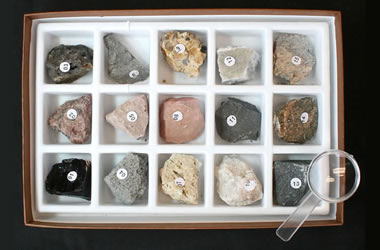
 |
Shale: Shale breaks into thin pieces with sharp edges. It occurs in a wide range of colors that include red, brown, green, gray, and black. It is the most common sedimentary rock and is found in sedimentary basins worldwide.
|
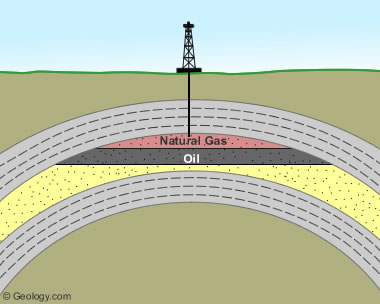 |
| Conventional Oil and Natural Gas Reservoir: This drawing illustrates an "anticlinal trap" that contains oil and natural gas. The gray rock units are impermeable shale. Oil and natural gas forms within these shale units and then migrates upwards. Some of the oil and gas becomes trapped in the yellow sandstone to form an oil and gas reservoir. This is a "conventional" reservoir - meaning that the oil and gas can flow through the pore space of the sandstone and be produced from the well. |
 |
| Shale in brick and tile: Shale is used as a raw material for making many types of brick, tile, pipe, pottery, and other manufactured products. Brick and tile are some of the most extensively used and highly desired materials for building homes, walls, streets, and commercial structures. |
 |
| Rock & Mineral Kits: Get a rock, mineral, or fossil kit to learn more about Earth materials. The best way to learn about rocks is to have specimens available for testing and examination. |
 |
| Oil shale: A rock that contains a significant amount of organic material in the form of solid kerogen. Up to 1/3 of the rock can be solid organic material. This specimen is approximately four inches (ten centimeters) across. |
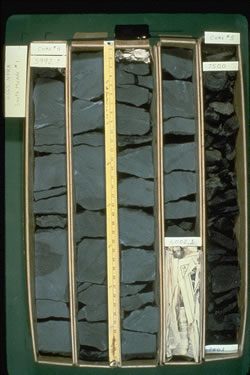 |
| Shale core samples: When shale is drilled for oil, natural gas, or mineral resource evaluation, a core is often recovered from the well. The rock in the core can then be tested to learn about its potential and how the resource might be best developed. |
 |
| Shale gas plays: Since the late 1990s, dozens of previously unproductive black organic shales have been successfully developed into valuable gas fields. See the article: "What is Shale Gas?" |
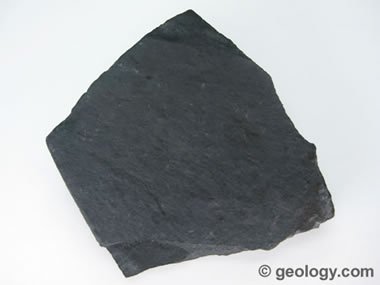 |
| Black shale: Organic-rich black shale. Natural gas and oil are sometimes trapped in the tiny pore spaces of this type of shale. |
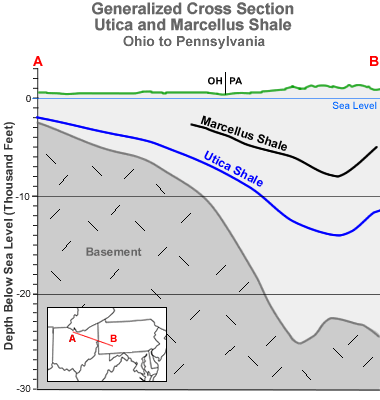 |
| Utica and Marcellus Shale: Two black organic shales in the Appalachian Basin are thought to contain enough natural gas to supply the United States for several years. These are the Marcellus Shale and Utica Shale. |
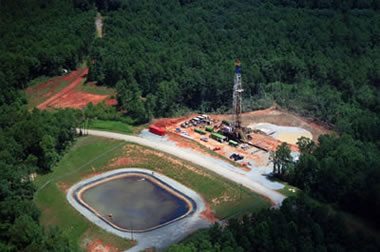 |
Natural gas shale well: In less than ten years, shale has skyrocketed to prominence in the energy sector. New drilling and well development methods such as hydraulic fracturing and horizontal drilling can tap the oil and natural gas trapped within the tight matrix of organic shales.
|
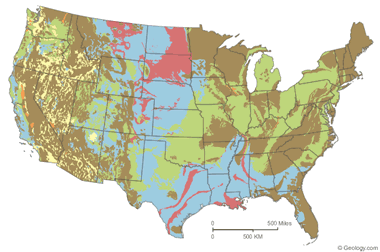 |
| Expansive soils map: The United States Geological Survey has prepared a generalized expansive soils map for the lower 48 states. |
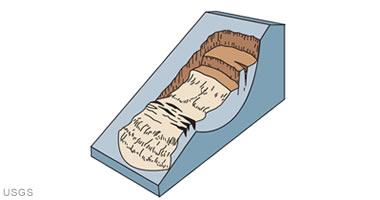 |
| Landslide: Shale is a landslide-prone rock. |
 |
| Shale delta: A delta is a sediment deposit that forms when a stream enters a standing body of water. The water velocity of the stream suddenly decreases and the sediments being carried settle to the bottom. Deltas are where the largest volume of Earth's mud is deposited. The image above is a satellite view of the Mississippi delta, showing its distributary channels and interdistributary deposits. The bright blue water surrounding the delta is laden with sediment. |
 |
| Shale on Mars: Shale is also a very common rock on Mars. This photo was taken by the mast camera of the Mars Curiosity Rover. It shows thinly bedded fissile shales outcropping in the Gale Crater. Curiosity drilled holes into the rocks of Gale Crater and identified clay minerals in the cuttings. |

No comments:
Post a Comment